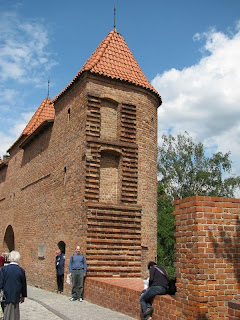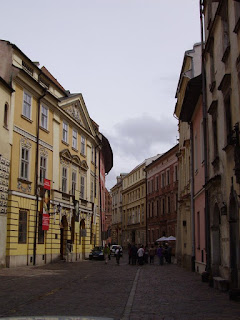Our hotel was located near the Palace of Culture and Science, the tallest building in Poland. The building was a gift from the Soviet Union in the 1950s. Many Poles, particularly during the Soviet era, viewed it as a symbol of Soviet domination.
Palace of Culture and Science

The first stop on our guided bus tour of Warsaw was the statue of Chopin in the Lazienkowski Park. We had a group photo taken in front of the statue. If anyone from the tour has a digital copy of the group photo, I would love to get a copy!
Chopin's mother was Polish, and his father was French. He spent his first 20 years in Warsaw and his last 18 in Paris, so the Polish love to say that he was more Polish than French. He is buried in France, but he asked his sister to send his heart back to Poland. His heart is buried in a church in Warsaw. So, the Chopin statue in this park is under a weeping willow tree next to a heart-shaped pond.
Statue of Chopin

Plaque in a Warsaw church saying "Here rests the heart of Frederic Chopin"

Monument commemorating the Polish uprising against the Germans during World War II
Jewish Ghetto Uprising Memorial

Tomb of the Unknown Soldiers with the Palace of Culture and Science in the background

Statue of Nicholas Copernicus
Planets and their orbits were inlayed in the ground around the statue.

Zodiac clock on the side of a building
The most scenic view of Warsaw:
The Old Town with colorful buildings, King Zygmunt's Column, and the royal winter palace on the right

The royal winter palace

Inside St. Anne's Church
The church had marble columns, but a lot of the fancy details were painted on the walls and ceiling as if they didn't have the money for the real things.

Phil by the Old City Wall

As the story goes, there were mermaids living in the nearby river, but it became too polluted, so the mermaids came out of the water, grew legs, and moved to Chicago, which has a larger Polish population than Warsaw.
A statue of a mermaid in the Old Town Square

At the end of our tour, we watched a movie about Warsaw before and after WWII. During the war, 85% of the city was destroyed from bombing and burning of the buildings. Amazingly, most of the city was rebuilt in the 1950s.
A plaque outside the house where Madame Curie was born

We took our first excursion of the trip to see Palace Wilanow. The palace was built by King John III. He and his wife and children lived there during the summer. There was a large memorial to the king and his wife outside:
Memorial to King John III and his wife

Palace Wilanow, which looks similar to Versailles

Julie in front of Palace Wilanow

We were not able to take photos inside of the palace, so we'll have to describe the interior.
We were able to see the king's and queen's sleeping chambers. The rooms had elaborate fabrics on the beds and as wallpaper. The painting on the queen's ceiling was recently restored and looked beautiful. In many of the other rooms, there were large collections of paintings.
In the hallways, the walls and ceilings were painted with religious and nature scenes. However, several have been destroyed by sun or water. There is also a large statue of King John defeating the Turks and Tartars, saving Christianity in Poland.
King John and his wife had 12 children, but only 4 survived to adulthood. The children's bedrooms were on the second floor and were supposedly only half height, but we did not get to see that floor of the palace.
Out back, there is a French style garden that was being renovated.


































































